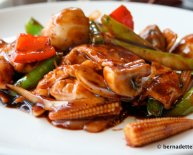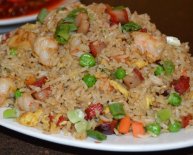
Fancy Chinese Cuisine Menu

Why there aren't many fancy, authentic Chinese restaurants
I eat a lot, and although there's almost no cuisine that I don't like, my favorite type of food is Chinese food.
Chinese food is the food I grew up with: my grandmother and parents are all pretty amazing at cooking the food they know best, namely Shanghainese food. The food culture at home is partly the reason why I like exploring the New York food scene, and over the past couple of years I've gotten to try restaurants ranging the whole gamut of price and cuisine. What I've noticed, however, is that there are very few fancy Chinese restaurants.
From my exploration, I believe that almost all Chinese restaurants fall into two categories. One is the hole-in-the-wall, which usually has limited or no seating, a low price point, and specialty over one particular kind of food (noodles, dumplings, barbeque, food from a specific region in China, etc.). The other category is the sit-down, family-style restaurant, where you order dishes to share with your group of friends or family. These restaurants tend to have wide menus that span a couple of Chinese cuisines (plus the cuisine of "Americanized" Chinese food), and the price point usually comes out to around $20-40 per person in Manhattan. There are also some Asian-fusion restaurants which have Chinese-inspired dishes, but let's consider only the restaurants focused on authentic Chinese cuisine for now.
There are a couple of fancy, authentic Chinese restaurants in Manhattan, but they are not as popular as either fancy restaurants of other cuisines or cheaper Chinese restaurants. Why are there so few restaurants in this category, and will we see more in the near future? Here are seven potential factors for why I think this phenomenon exists, and whether these trends seem to be changing.
Expectations
Expectations are always a bit of a circular problem. Right now, because American diners don't often see authentic, fancy Chinese restaurants, it's hard to gauge demand for these kinds of establishments, which is a damper on starting one. Diners also have a certain expectation of what the "Chinese restaurant" experience is like, which includes the kind of food you can get and for what price. If a restaurant wants to buck this trend and charge a higher price point, it will have to make food that diners perceive as notably better in some dimension, or offer a new, better dining experience.
The inertia of expectations is hard to overcome, but can begin to change with just one example of a successful fancy, authentic Chinse restaurant. An innovative restauranteur could take on this challenge any day, and with the growing foodie culture, I'm optimistic that this becomes more and more likely over time.
Alcohol
Let's face it, a lot of the "fanciness" at a restaurant can stem from the perceived quality of the alcohol selection, whether it be wine, beer, liquor, or cocktails. Chinese restaurants will sometimes have beer and wine, but there isn't a strong culture of pairing alcohols with Chinese dishes. Alcohol tends to be a social lubricant in Chinese meals, not so much a tool that enhances the food. Also, there isn't really a Chinese liquor that has both a sipping culture and a vibrant cocktail-crafting culture. So, drinks are rarely a significant factor in the Chinese restaurant experience today.
The alcohol factor might be a bit harder to overcome because there's so little precedent for a deep, high-quality alcohol selection at a Chinese restaurant. Who knows though; perhaps the innovation that overcomes current expectations of Chinese restaurants will relate to alcohol.
Size of Menu
Chinese food is a huge umbrella that encompasses many different regional cuisines, so many Chinese restuarants try to reflect this diversity in thir menu. In reality, we shouldn't be speaking so much about "Chinese" restaurants as we should about, specifically, Shanghainese restaurants, or Sichuanese restaurants, or Cantonese restaurants, etc. There is, it seems, already a slight trend, in Manhattan at least, towards clearer regional specializations for Chinese restaurants.
The problem with a wide menu, however, is that it puts the onus of the creation of the restaurant experience on the diners. At the fanciest restaurants, diners are usually forced to do the prix fixe option, where they have very few, if any, choices. The chef crafts almost the entire meal experience.
In contrast, a Chinese restaurant tries to be as accommodating as possible to its diners' potential preferences, and diners have to navigate a huge menu to figure out "what's good". In fact, the menu is sometimes filled with dishes which are obviously different permutations on the same base set of ingredients: X sauce on Y protein over Z carb. The whole experience of picking and choosing is both stressful and removes a "service" that the restaurant or chef can provide.
This factor is probably not hard to change. A fancy, authentic Chinese restaurant will most likely have a limited menu, and more responsibility will be on the chef to craft the experience.
Family Style Eating
Chinese food is traditionally consumed family-style, and Chinese restaurants have kept this tradition. For Chinese food, eating family-style provides the same kind of variety in tastes and textures as does having multiple courses in Western meals.
There is something charming, yet inherently casual, about passing big bowls or platters of food around the table to share. I'm not exactly sure why this is. Perhaps it's the hubbub caused by juggling plates and serving utensils around. Or perhaps it's the risk for spillage as food is in transit. It might be squeamishness around potentially cross-contaminating the dishes. Or, it could just be a problem with expectations, where people associate family-style with casualness and perosnal dishes as a luxury afforded by nicer restaurants.
I am not sure if this will have to change at a fancy Chinese restaurant. Having grown up with Chinese food, I feel like individualized dishes will take away much of the character and, frankly, fun of Chinese food, but I have little experience with Chinese food served this way.
The Demographics
Despite the growing Chinese-American population in the US, there are a few characteristics of this audience that are possibly holding back high-end Chinese restaurants.
The first characteristic is that there is not as large of an extremely wealthy, native Chinese population in the US. The kinds of customers who can support the truly high-end Chinese restaurants in China are not yet present in the U.S., so that particular kind of dining experience is not an obvious one to bring over to the States yet.
The second characteristic is that much of the Chinese-American population is the first generation to be raised in the US. These people, who are now starting their own families, grew up with a very particular conception of Chinese food, both at home and at restaurants. Home was where you can get the home-cooked comfort food, the kind hard to find in restaurants. Chinese restaurants were either these almost-cookie-cutter establishments with standardized food (food that their native parents probably looked down on), or were very Americanized establishments with a menu and taste completely distinct from what was produced at home.





















